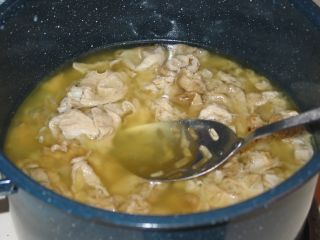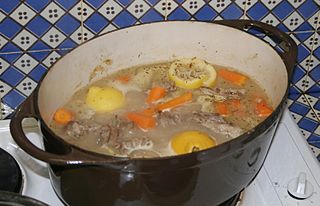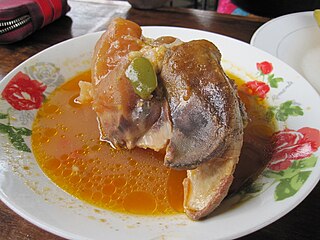Sheep's trotters, also referred to as lamb's trotters, [1] are the feet of sheep. [2] [3] They may be cooked by being boiled, broiled or fried, [2] [3] [4] and are used in various dishes. [2] [5] Sheep's trotters may also be parboiled and then finished by an additional cooking method, such as stewing. [6] They can be served with sauces such as white sauce or a brown gravy. [4] [6] Powsowdie is a Scottish broth or soup made from sheep's heid ('head'), that sometimes includes sheep's trotters as an ingredient. [7] Sheep's trotters are used in the preparation of lamb's trotters soup, which can also include leg meat. [8] Harqma is soup that is common in the Maghreb area of Northern Africa, and is sometimes prepared using lamb's trotters. [1] [8] They are also slow-cooked to make paya , which is popular in South Asian cuisine. It is popular amongst South Africans, adapted from the cuisine of India. Those of south Asian descent, and other South Africans often cook it with spices and sugar beans (pinto) or crab-eye beans (borlotti beans). It is a common belief that pigs are the only animal who have "trotters". Animals such as sheep, cows, horses and any animal with cloven-hoofed feet have "hoofs".

Turkish cuisine is the cuisine of Turkey and the Turkish diaspora. Although the cuisine took its current rich form after numerous cultural interactions throughout centuries, it should not be confused with other cuisines such as Ottoman cuisine or Seljuk cuisine. Turkish cuisine with traditional Turkic elements such as yogurt, ayran, kaymak, exerts and gains influences to and from Mediterranean, Balkan, Middle Eastern, Central Asian and Eastern European cuisines.

Tripe is a type of edible lining from the stomachs of various farm animals. Most tripe is from cattle, pigs and sheep.

Offal, also called variety meats, pluck or organ meats, is the internal organs of a butchered animal. The word does not refer to a particular list of edible organs, and these lists of organs vary with culture and region, but usually exclude skeletal muscle. Offal may also refer to the by-products of milled grains, such as corn or wheat.

Chitterlings, sometimes spelled chitlins or chittlins, are the large intestines of domestic animals. They are usually made from pigs' intestines. They may also be filled with a forcemeat to make sausage. Intestine from other animals, such as cow, lamb, goose, and goat is also used for making chitterling.

Avgolemono is a family of sauces and soups made with egg yolk and lemon juice mixed with broth, heated until they thicken.

Blanquette de veau is a French veal stew. In the classic version of the dish the meat is simmered in a white stock and served in a sauce velouté enriched with cream and egg. It is among the most popular meat dishes in France.
Romanian cuisine is a diverse blend of different dishes from several traditions with which it has come into contact, but it also maintains its own character. It has been mainly influenced by Turkish but also a series of European cuisines in particular from the Balkan Peninsula and Hungarian cuisine as well as culinary elements stemming from the cuisines of Central Europe.

Peasant foods are dishes eaten by peasants, made from accessible and inexpensive ingredients.

Tripe soup or tripe stew is a soup or stew made with tripe. It is widely considered to be a hangover remedy.

South African cuisine reflects the diverse range of culinary traditions embodied by the various communities that inhabit the country. Among the indigenous peoples of South Africa, the Khoisan foraged over 300 species of edible food plants, such as the rooibos shrub legume, whose culinary value continues to exert a salient influence on South African cuisine. Subsequent encounters with Bantu pastoralists facilitated the emergence of cultivated crops and domestic cattle, which supplemented traditional Khoisan techniques of meat preservation. In addition, Bantu-speaking communities forged an extensive repertoire of culinary ingredients and dishes, many of which are still consumed today in traditional settlements and urban entrepôts alike.

Bulgarian cuisine is part of the cuisine of Southeast Europe, sharing characteristics with other Balkan cuisines. Bulgarian cooking traditions are diverse because of geographical factors such as climatic conditions suitable for a variety of vegetables, herbs, and fruit. Aside from the variety of local Bulgarian dishes, Bulgarian cuisine shares a number of dishes with its neighboring countries, in particular with Turkish and Greek cuisine.

Arab cuisine is the cuisine of the Arab world, defined as the various regional cuisines of the Arab people, spanning from the Maghreb to the Mashriq. These cuisines are centuries old and reflect the culture of trading in ingredients, spices, herbs, and commodities. The regions have many similarities, but also unique traditions. They have also been influenced by climate, cultivation, and mutual commerce.

Khash is a dish of boiled cow or sheep parts, which might include the head, feet, and stomach (tripe). It is a dish of Armenian origin.

Fricassee or fricassée is a stew made with pieces of meat that have been browned in butter then served in a sauce flavored with the cooking stock. Fricassee is usually made with chicken, veal or rabbit, with variations limited only by what ingredients the cook has at hand.

Georgian cuisine consists of cooking traditions, techniques, and practices of Georgia. Georgian cuisine has a distinct character, while bearing some similarities with various national cuisines of the South Caucasus, the Middle East and Eastern Europe. Every region of Georgia has its own distinct style of food preparation. Eating and drinking are important parts of Georgian culture.
Romani cuisine is the cuisine of the ethnic Romani people. There is no specific "Roma cuisine"; it varies and is culinarily influenced by the respective countries where they have often lived for centuries. Hence, it is influenced by European cuisine even though the Romani people originated from the Indian subcontinent. Their cookery incorporates Indian and South Asian influences, but is also very similar to Hungarian cuisine. The many cultures that the Roma contacted are reflected in their cooking, resulting in many different cuisines. Some of these cultures are Middle European, Germany, Great Britain, and Spain. The cuisine of Muslim Romani people is also influenced by Balkan cuisine and Turkish cuisine. Many Roma do not eat food prepared by a non-Roma.

Cow's trotters are the feet of cattle. The cuts are used in various dishes around the world, especially in Asian, African, French, and the Caribbean cuisine. Latin American cuisine also uses cow's trotters for several traditional dishes.